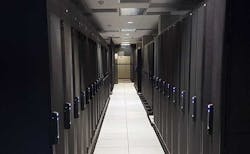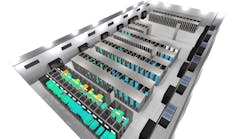Over the last three years, large hyperscale and cloud computing deals have provided most of the headlines for public data center companies during earnings season. During the second quarter of 2019, enterprise adoption came to the fore.
In a period of subdued hyperscale leasing, leading data center providers reported strong momentum in business with enterprise users re-aligning their corporate IT operations.
“Our efforts to penetrate enterprise demand are bearing fruit,” said William Stein, CEO of Digital Realty. “We landed an all-time high number of new logos this quarter, an encouraging indication.”
“We are seeing an acceleration in the (enterprise adoption) curve,” said Thomas Morton, President of Switch. “We’re also learning that as those customers come in and do an initial deployment, they tend to continue to do larger and larger deployments with us, which can be multi-megawatt.”
CyrusOne CEO Gary Wojtaszek said that more than 70 percent of the company’s deals in the second quarter were less than 500 kilowatts and enterprise-focused. “If you look at our results over the last three quarters, in spite of hyperscale business being somewhat muted, we’ve had record sales in enterprise – which comes with really high returns,” said Wojtaszek.
Iron Mountain reported strength in cross-selling data center space to existing enterprise customers of its records management business, according to CEO William Meaney. “We continue to demonstrate the strengths of our customer relationships when winning retail sales focused on large enterprises building private cloud infrastructure,” said Meaney.
At Equinix, CEO Charles Meyers cited strength in enterprise deals in the travel, legal and healthcare sectors, and record bookings in financial services. “We think there is a huge opportunity for us,” said Meyers. “We think the addressable market is actually expanding.”
The strong leasing reported by public data center providers is also likely to be good news for privately-held colocation companies that focus on the enterprise, a group including Cyxtera, DataBank, EdgeConneX, Evoque and Cologix.
Enterprise IT Spreads Across Cloud & Colo
The enterprise transition from on-premises data centers to third-party service providers isn’t a new trend, but it is a major driver of data center growth. The second quarter momentum continues a rational reallocation of enterprise IT resources across cloud platforms, colocation facilities and on-premises data centers. This transition has been a gradual process, and will continue for years.
In our 2019 forecast, Data Center Frontier noted that there are “signs that leading enterprises will face pressure to move more quickly in 2019, as industries are disrupted by the success of early movers in the digital business transition.”
The cloud and colocation industries have reached a level of maturity that offers compelling value, breaking down the historic resistance to moving data offsite. An accelerating factor is the aging of on-premises facilities. Construction of these capital-intensive projects slowed dramatically after the financial crisis of 2008, and a growing number of companies are facing decisions about their infrastructure.
“Enterprises with older data centers don’t want to rebuild them or build new ones due to high capital costs,” said Gartner’s Susan Moore. “They would rather have someone else manage the physical infrastructure.”
Gartner predicts that by 2025, 80 percent of enterprises will shut down their traditional data centers. In fact, 10 percent of organizations already have.
“Many organizations are rethinking the placement of applications, based on network latency, customer population clusters and geopolitical limitations — for example, the EU’s General Data Protection Regulation (GDPR) or regulatory restrictions,” writes Moore in a Gartner blog post.
Gartner’s 2019 IT Key Metrics Data shows that the percentage of the IT budget spent on data centers has decreased over the past several years, and now accounts for just 17 percent of the total.
Growth Ahead for Interconnections
The pickup in enterprise deals also is driving growth in interconnections (connections between networks within a data center), as customers seek “on-ramps” to cloud platforms and work to manage network costs.
“Those enterprises are looking to interconnect with several cloud providers and network providers and services,” said Maile Kaiser, Senior Vice President of Sales and Business Development at CoreSite. “So we expect to see a growth in cross connects with those customers coming on board.”
Digital Realty’s Stein called the second quarter enterprise activity “a promising sign for future interconnection revenue growth prospects.”
Some of the strongest interconnection growth was seen at CyrusOne.
“Our interconnection business grew at 20 percent this quarter, which is among the fastest rates at which it has ever grown,” said CyrusOne’s Wojtaszek. “Our IX business this quarter just kind of knocked it out of the park.
“No one thinks about CyrusOne as kind of a go-to IX company,” Wojtaszek continued. “But we’ve seen really big growth, because the data sets are exploding at a really, really fast pace. And the compute nodes and the storage nodes in the data center landscape are growing at a much faster rate than the network nodes. We’re seeing a change in landscape in the network topology, and the growth in cross connects here is just the result of that.”
Wojtaszek said CyrusOne’s average number of cross connects per customer has increased to 21. “That’s up seven-fold from when we first started tracking this about seven years ago,” he said.
“We’re seeing a change in landscape in the network topology, and the growth in cross connects is the result of that.”
CyrusOne CEO Gary Wojtaszek
Wojtaszek cited the important role of Megaport, one of a group of startups bringing the power of software-defined networking (SDN) to multi-tenant data centers. These companies – which include Megaport, PacketFabric and Epsilon – provide network capacity that can be configured through a web portal, dramatically simplifying the way data center customers manage their connectivity. These SDN specialists have proven valuable to wholesale data center providers by providing access to a larger universe of connectivity through a single tenant.
“What we’re seeing is that the cloud vendors are directing their customers to go to Megaport to pick up access to the cloud,” said Wojtaszek. “So it’s really kind of symbiotic relationship that we have with Megaport. They’ve enabled us to attract customers that connect them into the cloud, and we’ve done really well just because of the hybrid model that we’re going after. As they continue to do more and more deployments, they require more cross connects.”






